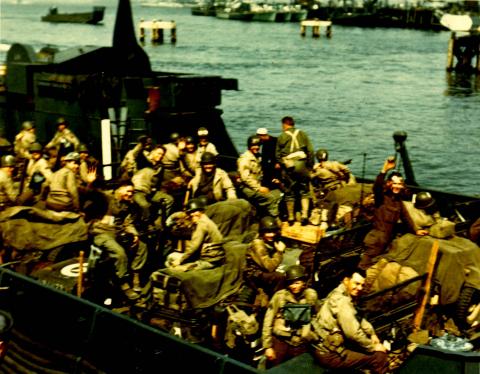-
Table of Contents
- 0. STORY PREFACE
- 1. THE WEATHER BREAKS
- 2. A CROSS-CHANNEL ATTACK
- 3. WHO WILL COMMAND?
- 4. D-DAY COMMANDERS
- 5. LET'S GO!
- 6. CROSSING THE CHANNEL
- 7. DEATH ON THE SHORE
- 8. DIGGING IN; FIGHTING ON
- 9. UTAH BEACH
- 10. OMAHA BEACH
- 11. DECEPTION
- 12. CANADIANS LAND AT JUNO BEACH
- 13. BRITS LAND AT GOLD BEACH
- 14. ...AND SWORD BEACH
- 15. STUNNING D-DAY FACTS
American troops are onboard their landing craft, ready to leave Britain for their amphibious assault on German-occupied France. Their next stop will be Normandy; their next engagement will be the battle to break Germany’s “Atlantic Wall.” The U.S. Army Center for Military History describes this picture: “View of an LCT with American troops and equipment loaded aboard awaiting the signal for the assault against the continent. England. Undated - June 1944.”
When Eisenhower gave the order to "go," most of the Allied assault troops had been aboard their transport vessels for hours. Berthed in various ports throughout the south of England, they were waiting for the weather to break.
Thanks to maps and photographs, from official military sources and national archives, we can look back to view important scenes from June 5, 1944.
- Coast Guard Flotilla 10, in the background, with British landing craft preparing to leave for the Normandy invasion. These landing craft brought US soldiers to Omaha Beach.
- Departing from various British ports as part of "Operation Neptune," the ships and troops reconnoitered in the North Atlantic, joining at a spot called "Picadilly Circus" and proceeding, as a convoy, to their individual destinations: USA to Utah and Omaha Beaches; Britain to Gold and Sword Beaches; Canada to Juno Beach.
- The four-hour crossing through rough waters was difficult.
- A convoy of Landing Craft Infantry (Large) made its way to Normandy's beaches on June 6th. Each LCI(L) - the shorthand term for such landing crafts - towed a barrage balloon to protect the vessel and its men from low-flying German aircraft. Some of the men on board attended Mass before they put themselves in harm's way.
- Landing Ship Tanks (there were about 1,051 LSTs used in WWII) were built to carry troops and transport supplies. On D-Day, USS LST-73 (which ferried troops of the 8th Infantry Regiment, 4th Infantry Division) was also protected by a gas-filled balloon.
- "Higgins Boats," the nickname for "Landing Craft, Vehicle, Personnel" (LCVP), also brought some of the 156,000 men to the shores of France on June 6th.
- "Rhino Barges" were used to off-load tanks and trucks - and ferry them ashore - during the first hours of the invasion.
- The U.S. Coast Guard rescued men whose ships, attacked by German firing power, sank before they reached the beach. Others were rescued nearer shore where they were given "First Aid" treatment.
- LCVPs brought Allied troops to the beaches. Some of the men carried M1903 rifles and M1 carbines. Ahead - for many - lay death and serious injury. For others, life in a beach foxhole (and fighting the dug-in Germans) would forever redefine the meaning of June 6th.
- American troops landed at Normandy beaches dubbed "Utah" and "Omaha." Canadians landed at "Juno," while the British were responsible for "Gold" and "Sword" beaches.
- With Nazi radar operating at Cherbourg, and on the Normandy beach itself, the Allies headed toward their landing destinations. German batteries (referred to in this French-language map as "Batterie Allemande") were waiting.
- When Allied planes (sent ahead to "soften up" the Germans before the invasion began) crashed that morning, no one needed a "black box" to explain what went wrong.
Hitler's efforts to isolate Great Britain, and to hold that country hostage, were about to end forever.
-
Table of Contents
- 0. STORY PREFACE
- 1. THE WEATHER BREAKS
- 2. A CROSS-CHANNEL ATTACK
- 3. WHO WILL COMMAND?
- 4. D-DAY COMMANDERS
- 5. LET'S GO!
- 6. CROSSING THE CHANNEL
- 7. DEATH ON THE SHORE
- 8. DIGGING IN; FIGHTING ON
- 9. UTAH BEACH
- 10. OMAHA BEACH
- 11. DECEPTION
- 12. CANADIANS LAND AT JUNO BEACH
- 13. BRITS LAND AT GOLD BEACH
- 14. ...AND SWORD BEACH
- 15. STUNNING D-DAY FACTS


 Back
Back
 Next Chapter
Next Chapter

 Back
Back
 Next Chapter
Next Chapter


